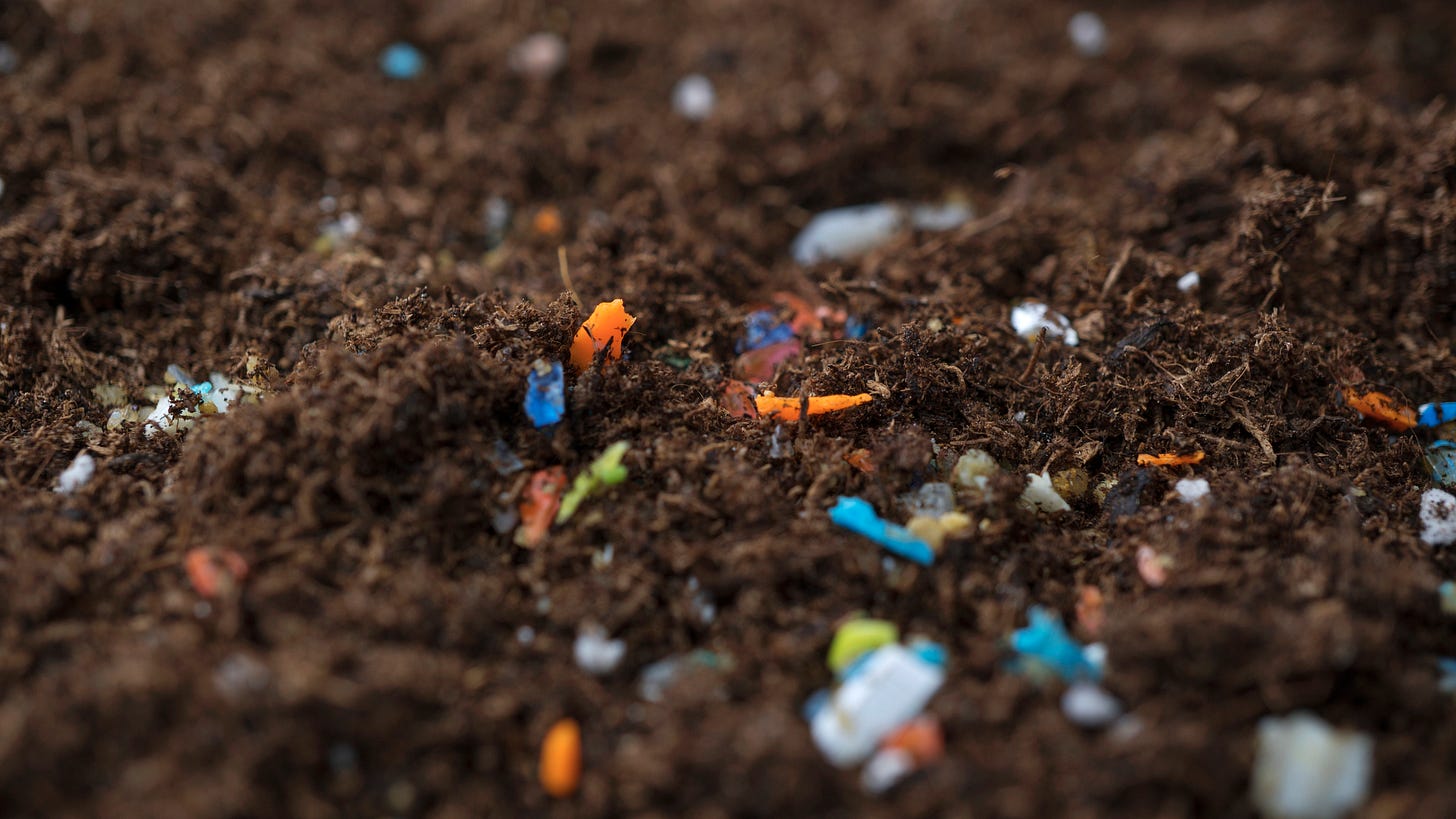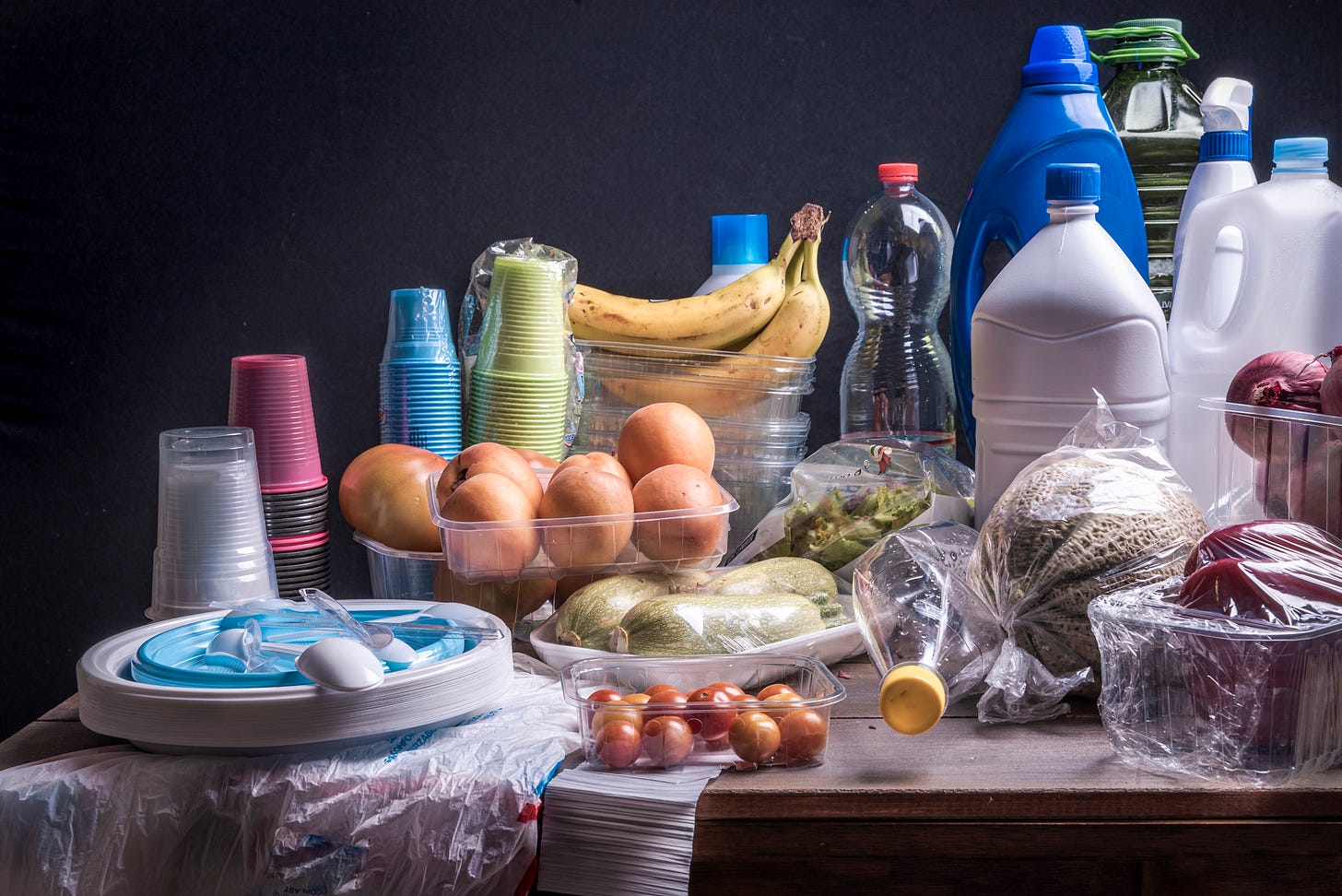Life Is Plastic, Not Fantastic
Why we can’t stop at plastic straws & why this year is key
I don’t know about you, but I’m finding it hard to be my normal energetic, bouncy self this week.
Perhaps it’s the cold, mostly grey weather and the lack of sunshine. Perhaps it’s the seemingly endless and relentless stream of bad news: Navalny, Rafah, the mandatory conscription in Myanmar, etc etc.
There isn’t much I can do about the latter but I’m taking comfort in the knowledge that the former is not going to last. Spring - and the extra hours of sun - will be arriving soon.
In the meantime, I’m relying on a never-ending supply of green tea. Stay safe and warm folks!
There won’t be Thin’s Pickings this week because this issue is already quite long.
Since their mass production started over seven decades ago, plastics have become a ubiquitous presence in our kitchens, whether it’s for storage (to put away leftovers or wrap up pre-chopped vegetables and meat), cooking (non-stick pans, blenders, spatulas, kettle, mixing bowls), or eating and drinking (utensils, bowls, tea bags).
They are also present in many aspects of the food value chain, and some are more visible than others.
“Plastics are used for everything from seedling trays and irrigation tubing to pesticide containers and livestock feed bags,” according to the UN Food and Agriculture Organization (FAO).
Mulch films, films and nets for polytunnels and greenhouses, bottles to transport liquid pesticides and fertilisers, coatings on fertilisers, pesticides and seeds, storage equipment and most fishing gear are also made of plastic, the FAO said.
In 2021, the FAO published a landmark report which estimated that agricultural value chains used 12.5 million tonnes of plastic products in plant and animal production and 37.3 million tonnes in food packaging in 2019.
The agenday said data were “not available for usage in storage, processing, and distribution”, but said global demand for greenhouse, mulching and silage films are estimated to increase by 50% between 2018 and 2030.
The problems? Besides the fact that 99% of plastics are derived from fossil fuels, the same sources whose unmitigated burning, by us, is causing climate change?
Well, a majority of agricultural are single-use and most are poorly managed and not recycled (or even recyclable, in some cases).
Now a coalition of scientists who would like to see the end of plastic pollution from food systems has published a new policy brief, stressing the urgent need to address the key sources and drivers.
Industrial food systems are both “a leading driver of plastic production” and “simultaneously vulnerable to all plastic pollution impacts”, the brief said.
Window of Opportunity
There is a short window of opportunity to tackle this problem. In March 2022, nations committed to end plastic pollution and develop a legally binding treaty, a draft of which should be ready by the end of this year. There are two more meetings scheduled for the Intergovernmental Negotiating Committee on Plastic Pollution (INC).
Scientists and environmentalists are calling for a mandatory global cap on plastic production, but as can be expected, the industry is resisting (more on that below in the section on recycling).
Plastic pollution has been covered extensively by many news outlets and journalists with far more knowledge on the issue than me, but a lot of the time, agricultural plastics don’t get a mention, which is why I spoke to Joe Yates and Megan Deeney, the policy brief’s corresponding authors from the London School of Hygiene & Tropical Medicine, about the scale of the problem and what can be done about it.
The Scientists' Coalition for an Effective Plastics Treaty, which Joe and Megan are a part of and which published the brief, is an international network of experts working to provide solid evidence to help with the treaty process.
If you’re interested to read more on food systems plastics, there are some resources here. And if you’re attending or following the next session of the INC in Ottawa in April, reach out to Joe here and to Megan here.
Also, the brief is only three pages so I urge you to read it in full.
Q: What are the links between plastic production, use, and pollution and our current food systems?
A: Food systems are really at the centre of a viscous plastic pollution cycle. The ways that we produce, distribute, consume and dispose of food are driving global plastic demand, and these systems are simultaneously suffering from the adverse effects of plastic pollution.
Q: How big is the problem? The FAO estimated the 12.5 million tonnes of plastic used in agricultural production as about 3.5% of the global plastic production. That seems small-ish?
A: This is just an estimate for plastics used in agricultural production alone. If you look at the whole food system it will be higher. And alarmingly, it’s projected to grow, potentially tripling by 2060 if we continue on our current trajectory.
Data are hard to come by as industry sit on a lot of it, but food and drink packaging alone is estimated to account for between 10% – 20% of plastic produced.
It's important to consider what these plastics are used for and what happens thereafter. Although these percentages may seem small-ish, food system plastics are among the most single-used, short-lived, and poorly disposed of materials on the planet. So they have disproportionately high end-of-life pollution impacts – often on marginalised communities.
(For a real-life example of how this manifests in poor nations, read this investigation from Lighthouse Reports on rich countries in Europe and North America dumping their plastic waste in low-income communities in Myanmar. This has poisoned the environment and endangered lives, but the citizens are too afraid to speak up under the military’s iron-fisted rule. There’s even a detailed methodology for journalists who want to replicate this.)
Q: What harms can it cause?
A: Plastic pollution poses risks to food systems in many different ways.
Plastics, micro and nano-plastics and plastic-related chemicals pollute agricultural and aquatic environments, creating potential hazards for food production. They are consumed by livestock and taken up into human food sources.
Machinery used in food manufacture and plastic packaging further contaminate our foods with microplastics and thousands of chemicals, many of which migrate into foodstuffs and are of concern to human health.
In short, the food system is one of the most direct human exposures to all forms of plastic pollution, which we are quite literally consuming.
Not only this, but industrial processes throughout the plastic life cycle, from oil and gas extraction all the way to incineration, landfill and waste mismanagement release greenhouse gases, air pollutants and toxic chemicals further damaging human health and the natural environment on which food production and supply depends.
Q: Do you think the linkages with plastics is a bit of a blind spot when it comes to looking at food systems sustainability?
A: It is, unfortunately. Plastic pollution is a problem both of and for food systems – with implications for food production, food safety, food security, and by extension human and planetary health (not to mention equity and justice!).
So the absence of this in the big ‘transformation’ agendas and debates is quite surprising. There were a few scant mentions amid the noise of UNFSS, mainly around packaging and calls for ‘eliminating plastics from the food system’. As you can imagine, this is not as simple as it sounds.
Many plastics are certainly non-essential and could be eliminated tomorrow, but others might not be and will require safe, sustainable and functional alternatives and/or supporting policies to phase out without creating unintended consequences. It’s an issue that deserves the nuance and care given to other areas of food systems sustainability.
This is not to say that plastics haven’t been researched and discussed at different sub-sectors of the food system. There have been huge efforts around fisheries and marine environments for instance. And recently FAO has been developing a voluntary code of conduct on agricultural plastics.
But there still seems to be a siloed approach and we remained concerned that a challenge of this gravitas and urgency deserves systems-level recognition and collaboration across disciplines and sectors.
Q: Is anything being done to combat this (beyond the campaign against plastic straws)?
A: Ahh, plastic straws! Quite the symbol of a problem too narrowly-defined. And a cautionary tale of false solutions for challenges that are not one dimensional.
Plastics aren’t just a concern for environmental sustainability, but for human health, too. There’s no doubt that plastic straws are a problem for the environment, but evidence shows that many paper straws (and paper coffee cups) have their own problems, too, in that they contain (and can leach into food stuffs) hazardous substances, such as per- and polyfluoroalkyl substances – known as PFAS, or ‘forever chemicals’.
In terms of recognising plastics as a food systems issue, we have some recommendations on this coming soon. But more collaboration and evidence would be a start, to demonstrate where policies can deliver rapidly co-benefits across food and nutrition security, public health, the environment and economics. Such collaboration could foster much needed momentum and political will.
By the end of this year, governments from around the world are set to conclude a two-year process to develop a global, legally-binding treaty to end plastic pollution. We are in an absolutely critical window of opportunity to ensure that this treaty is bold and forward-thinking enough to end the wave of plastic pollution, protect the sustainability of our food systems and to bring us back on track for promoting planetary health.
Q: Where are the gaps/shortcomings and opportunities?
A: There’s a real lack of evidence on the context specific impacts of food system plastics in low-income settings. This is particularly worrying because this means that policies and programmes are not being guided in ways that reflect local realities.
We need more joined up evidence to understand the true impacts on food systems plastics on human health. And there is a lot to do around combatting the commercial drivers of the plastic problem, not least by fortifying science-policy processes against conflicts of interest.
There is a real opportunity within the Global Plastics Treaty process to ensure that Big Food, Petrochemical and Plastic industries are much more transparent about how much plastic is being used globally, how it is produced and disposed of and what chemicals it contains.
These data are critical for evaluating the risks, policy effectiveness and alternatives to plastics as we try to move towards truly sustainable food systems. The treaty has already put pressure on companies, and for the first time more than 3000 industry groups, including Big Food companies like Unilever, reported plastic usage data. We are looking forward to these data being made available.
Is Recycling A ‘Con’?
Of course, I couldn’t write an issue about plastic pollution without mentioning a damning new report from the Center for Climate Integrity, which I learnt through Mike Shananhan’s Global Nature Beat newsletter.
“Big Oil and the plastics industry deceived the public for decades and caused the plastic waste crisis,” the report said, by engaging “in fraudulent marketing and public education campaigns designed to mislead the public about the viability of plastic recycling as a solution to plastic waste”.
Here are some of their most shocking findings:
Some of the largest oil and gas companies are among the 20 petrochemical companies responsible for more than half of all single-use plastics generated globally. ExxonMobil, for example, is the world’s top producer of single-use plastic polymers.
The vast majority of these plastics cannot be “recycled” - meaning they cannot be collected, processed, and re-manufactured into new products. As of 2021, the U.S. recycling rate for plastic is estimated to be only 5% - 6%.
The cost of producing recycled plastic is much higher than producing virgin plastic, and therefore plastic recycling is not economically viable. The recycling process - from collection to sorting to processing to transport - requires more time, labour, and equipment to achieve a lower quality and less efficient output than the process of making virgin resin from fossil fuels.
The industry also continues to push back on efforts to curb the most damaging forms of plastic, so much so that the European Parliament is launching an investigation into the lobbying tactics and extreme pressure on parliamentarians with regards to a bill aimed at reducing package-related waste. Some have said it was one of the most lobbied pieces of EU legislation ‘ever’, which is saying something.
As always, please feel free to share this post and send tips and thoughts on mastodon @ThinInk@journa.host, my LinkedIn page, twitter @thinink, or via e-mail thin@thin-ink.net.








Great roundup of the latest progress on fighting plastic pollution! That new report by the Center for Climate Integrity infuriated me.